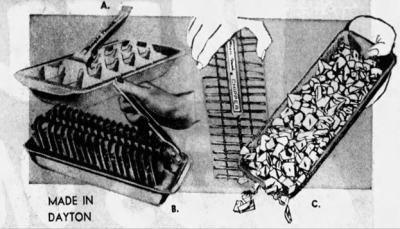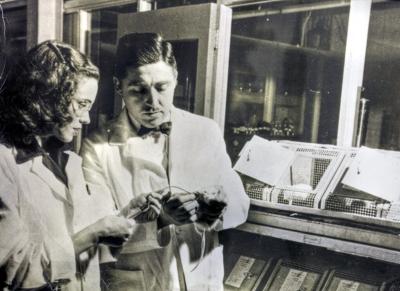From pioneering advancements in aviation to groundbreaking contributions in technology and beyond, Dayton's legacy of ingenuity is woven into the fabric of history. Join us as we continue to celebrate our 30th anniversary, by highlighting 30 creations that have not only transformed industries but also left an indelible mark on the world stage, showcasing the enduring impact of Dayton's inventive prowess.
1. First Practical Airplane - The Wright Brothers
Wilbur and Orville Wright, American aviation pioneers, revolutionized flight with their groundbreaking innovations. Observing birds' wing movements for inspiration, they developed the concept of "wing warping" and incorporated a movable rudder into their designs. On December 17, 1903, their perseverance paid off as they achieved the first free, controlled flight of a powered, heavier-than-air aircraft. This historic flight lasted 59 seconds, covering 852 feet—a remarkable feat that marked the dawn of modern aviation.
2. Pop-top/Pull-tab Can - Ermal Fraze
In the 1950s, opening a can of beer required a church key, a small metal tool with a triangular tip for piercing cans and a rounded end on the other side for opening bottles. However, at a 1959 picnic, Ermal Fraze forgot his church key and improvised by using his car's fin to open a can. This moment of ingenuity led to the invention of the pop-top, revolutionizing the way we open cans forever. Without Fraze's innovation, we might still be puncturing triangular holes in cans instead of enjoying the convenience of the modern pop-top.
3. Stepladder - John H. Balsey
John H. Balsey's invention of the stepladder transformed how we reach new heights with ease and safety. Before its creation, accessing elevated areas often required unstable and precarious means. Balsey's innovation provided a stable and portable solution, featuring hinged steps that could be folded for convenient storage. With its patent secured on February 8, 1870, Balsey's creation became a staple in households and industries alike. His subsequent patents for an adjustable table leg and a paper bag machine showcased his ingenuity, but it was the stepladder that earned him the title of "The Stepladder King."

4. Ice Cube Tray With Lever - Arthur J. Frei
Arthur J. Frei, an inventive mind at Frigidaire, transformed the way we chill our drinks with his ingenious creation—the ice cube tray. With 23 patents to his name, Frei's innovation revolutionized ice-making convenience. Gone were the days of struggling to release ice cubes from metal trays; Frei's quick-release lever simplified the process, making ice cubes readily available with just a simple twist rather than running hot water over the metal trays.
5. Microfiche - Carl Carlson
Carl O. Carlson's invention of microfiche marks a pivotal moment in the evolution of document storage and management. With the creation of this compact film technology, Carlson introduced a revolutionary solution to the challenge of efficiently storing vast amounts of information. Microfiche allowed libraries, archives, and organizations to condense extensive collections into smaller files, making it easier to access and preserve valuable documents. This innovation not only streamlined data management processes, but also contributed to the democratization of information by enhancing accessibility.
6. Back Pack Parachute - Floyd Smith
Floyd Smith, the innovative mind behind the back pack parachute, changed the course of aviation history with his groundbreaking invention. On March 28, 1919, at McCook Field in Dayton, Ohio, civilian Leslie Irving made history by executing the first-ever jump from an airplane, equipped with a free back pack parachute. Irving's daring leap from a DH-9 aircraft, piloted by none other than Floyd Smith himself, showcased the reliability and effectiveness of Smith's revolutionary design. This original parachute is on display at the National Museum of the U.S. Air Force. You can also visit the Aviation Trail Parachute Museum, co-located at the Dayton Aviation Heritage National Historical Park's Wright-Dunbar Interpretive Center.
7. Collapsible Portable Crib - E. R. Churchwell
E.R. Churchwell, a visionary inventor, revolutionized childcare with the creation of the first collapsible and portable baby crib. Recognizing the need for space-saving solutions for families with infants, Churchwell's innovative design offered unprecedented convenience and versatility. This groundbreaking crib provided parents with the flexibility to ensure their child's comfort and safety wherever they traveled. Churchwell's invention not only simplified parenting but also paved the way for future advancements in portable childcare equipment,
8. Space Food - Maurice Krug
Dayton Engineer Maurice Krug revolutionized space exploration with his ingenious invention: space food. Recognizing the unique challenges astronauts encountered while dining in zero-gravity environments, Krug pioneered the development of specially designed meals tailored for space missions. His innovative solutions, which initially consisted of serving a soft, mushy applesauce squeezed from a tube to prevent food from floating freely in the spaceship, not only addressed the practical concerns of eating in space, but also paved the way for sustained human presence beyond Earth's atmosphere.
9. Electric Automobile Starter - Charles F. Kettering
Next time you start your car with a simple push of a button or turn on the A/C to beat the summer heat, spare a moment for Charles F. Kettering, the visionary behind these everyday conveniences. In 1908, at the request of his friend Edward Deeds, Kettering embarked on a mission to improve the reliability of cars' electrical systems and eliminate hand cranking for starting. Back then, ignitions were temperamental, and acetylene gas trumped electricity for lighting. Kettering's spark ignition design not only revolutionized Deeds' kit car but also paved the way for the founding of the Dayton Engineering Laboratories Company, later known as Delco.
10. Freon - Thomas Midgley Jr. & Charles F. Kettering
In the perilous world of 1920s refrigeration, safety was a luxury few could afford. That all changed when Thomas Midgley Jr. embarked on a mission to revolutionize cooling technology. Faced with the deadly consequences of refrigerant leaks, Midgley sought a solution that was stable, nonflammable, and safe for human consumption. In a stroke of genius, he formulated dichlorodifluoromethane, better known as freon—a game-changer in the realm of refrigeration. Unlike its hazardous predecessors, freon posed no threat to life or property. Midgley, ever the showman, famously demonstrated its safety by inhaling a hefty dose and extinguishing a candle flame!

11. Cash Register - James Ritty
In 1879, James Ritty, a Dayton saloon owner, faced a common dilemma: rampant employee theft. Determined to stem the losses, Ritty drew inspiration from an unlikely source—the mechanics of a steamship. Envisioning a solution to the manual cash transaction process, he collaborated with his brother John, a skilled mechanic, to craft the world's first cash register. Constructed of brass, wires, and gears, this innovative device, aptly named the "Incorruptible Cashier," revolutionized business operations. With a simple press of a button, transactions were swiftly recorded, providing an invaluable audit trail to combat theft. The establishment of the Ritty Manufacturing Company in 1880 marked the dawn of a new era in retail efficiency and accountability.
12. Human Heart-Lung Machine - Leland Clark
In 1951, the collaboration between cardiologist Samuel Kaplan, surgeon James Helmsworth, and chemist Leland Clark yielded a groundbreaking invention—the world's first functional heart-lung machine. This revolutionary device, built upon Clark's earlier development of a bubble oxygenator, marked a significant leap forward in cardiac surgery. Clark's pioneering work extended beyond this milestone, encompassing innovations such as the oxygen electrode and the utilization of perfluorocarbons in liquid breathing and artificial blood compounds. His contributions continue to shape the landscape of medical science and cardiovascular care.
13. Rotary Solenoid - George H. Leland
Amidst the turmoil of wartime challenges in the late 1930s to early 1940s, the Army Air Corps turned to Leland, seeking a solution for accurately dropping small bombs from high-speed aircraft. This collaboration birthed the A-4 bomb release device, featuring an electrical solenoid. Innovatively, George introduced the rotary solenoid, renowned for its safety and immunity to shock, revolutionizing aerial warfare technology.
14. Motorized Wheelchair - Levitt Luzern Custer
In the wake of World War I's devastation, Luzern Custer, attuned to the needs of wounded soldiers, pioneered a transformative solution. Witnessing over 4,000 amputees seeking rehabilitation at Dayton Soldiers' Home, Custer recognized the crucial necessity for independence. Introducing the Custer Invalid Chair, a revolutionary three-wheeled vehicle powered by batteries, he empowered veterans with newfound mobility. This innovative design, akin to a self-propelled wheelchair, enabled users to traverse distances of 10 to 15 miles before requiring a recharge. Custer's ingenuity culminated in patent #D53,891 in 1919, marking a monumental leap forward in enhancing the lives of the physically challenged.
15. Price Tag Affixing Machine - Fred Kohnle
In 1902, Frederick Kohnle of Dayton revolutionized the retail landscape with his groundbreaking invention: the first automated price tag affixing machine. This device streamlined the laborious process of tagging merchandise in stores and shops. With a single stroke of the operating handle, the machine seamlessly produced tags from a roll of paper, imprinting them with price and other essential information, before securely stapling them to the merchandise with a wire staple. Kohnle's invention eliminated the need for time-consuming handwritten tags, marking a significant leap forward in efficiency and convenience for retailers everywhere.
16. Surgical Goniometer
Wayne Hardy's innovative goniometer revolutionized surgical procedures, particularly in the realm of brain surgery. Designed to assist in the precise treatment of neurological diseases like tremors and rigidity, this apparatus enables surgeons to perform targeted interventions with unparalleled accuracy. By incorporating cutting-edge techniques such as lesioning, electrocautery, ultrasound, freezing, or chemical introduction, the goniometer facilitates controlled destruction of specific brain areas, leading to remarkable improvements in patient outcomes.
17. Gas Masks - Daniel L. Schaeffer
Daniel Webster Schaeffer, an inventive mind working at the Adam Schantz Brewery in 1900, faced a critical safety issue: the risk of gas exposure for workers entering casks. Motivated by the well-being of his colleagues, Schaeffer devised a primitive yet ingenious solution—an early gas mask fashioned from a derby hat. With slits for the eyes and rubber tubes for air circulation, this makeshift apparatus aimed to safeguard against toxic fumes. Schaeffer's ingenuity didn't stop there; he obtained a patent for his invention on September 25, 1900. Over time, his design evolved into the gas masks utilized in World War I, after the patent was acquired by Mr. Schantz and eventually sold to the government. Today's gas masks owe their lineage to Schaeffer's initial "derby" contraption, a testament to his pioneering contribution to respiratory protection technology.
18. Liquid Crystal Display (LCD) - John L. Janning
An employee of NCR, John L. Janning revolutionized technology with his pioneering work on liquid crystal displays. With his breakthrough oblique molecular alignment technique, Janning enabled large-scale LCD manufacturing in the early 1970s. The compact and energy-efficient nature of LCDs led to their rapid adoption in various devices, starting from watches and calculators and expanding to computer monitors, TV screens, cell phones, and beyond.

19. Cheez-Its - Green & Green Company
Delve into the intriguing origins of everyone's favorite cheesy snack, Cheez-It! While the official invention of Cheez-It dates back to 1921 by the Green & Green Company, its roots trace even farther. In 1847, Dr. William Wolf of Dayton recognized the dietary needs of his patients and created a unique hard butter cracker known as the Dayton Cracker. Dr. Wolf's creation sparked a surge in the cracker-baking industry in the city, laying the foundation for the iconic Cheez-It we know and love today.
20. Trapper Keeper - E. Bryant Crutchfield
A staple of school supplies invented by Mead's own E. Bryant Crutchfield in the late 1970s: The Trapper Keeper. This innovative binder revolutionized organization for students with its clever design, featuring folders and pockets to neatly store all essential school supplies. Throughout the 1980s and 1990s, the Trapper Keeper soared in popularity, with over 75 million units sold.
21. The Bar Code - Paul McEnroe
In today's bustling supermarkets, the convenience of the checkout process is often taken for granted. Gone are the days of manual price stamping, replaced by the seamless scanning of barcodes on every product. This transformative technology, the Universal Product Code (UPC), has revolutionized retail worldwide for the past 50 years. Paul McEnroe, an accomplished engineer with over two decades of experience at IBM, spearheaded the development of this groundbreaking system. His leadership and innovation paved the way for billions of barcode scans daily, shaping the modern shopping experience as we know it.
22. Movie Projector - Charles Francis Jenkins
Before the digital era transformed cinema, theaters relied on projectors descended from Charles Francis Jenkins' Phantoscope. Jenkins decided to further his education after this initial development and returned to school in 1895 at the Bliss School of Electricity in Washington, D.C., where he befriended Thomas Armat. Together, they enhanced Jenkins’ original design and showcased their improved projector at the 1895 Cotton States Exposition in Atlanta, Georgia. Guests paid 25 cents to experience moving pictures projected, a moment that many historians consider the birth of the movie theater. This pioneering invention by Jenkins and Armat set the stage for the modern cinematic experience.
23. Ethyl Leaded Gasoline - Thomas Midgely
In the early 20th century, engine knock plagued automobile engines, threatening their very existence. Enter Thomas Midgley Jr., whose tireless research led to a groundbreaking solution. After extensive experimentation, Midgley uncovered the remarkable anti-knock properties of tetraethyl lead (TEL) as a fuel additive. Not only did TEL eliminate engine knock, but it also boosted engine performance and speed. Backed by the support of major players like GM, oil companies, and other car manufacturers, TEL hit the market on February 1, 1923, under the brand name Ethyl, forever transforming the automotive landscape. As technology advanced, lead was eventually phased out of gasoline due to health and environmental concerns, but it helped put America on wheels in the first half of the 20th century.
24. Microencapsulation - Barrett K. Green
Barrett Green, a Cornell University graduate, made significant contributions to science during his tenure at National Cash Register in Dayton, Ohio. Green pioneered microencapsulation, a groundbreaking technique that revolutionized carbonless paper production. His patent for microencapsulation, granted on July 5, 1955, marked a milestone in printing technology. With this innovation, the bottom of the top sheet is coated with microencapsulated dye, while the top of the subsequent sheet receives a layer of reactive clay material. When pressure is applied to the top sheet through writing or typing, the microcapsules rupture, releasing dye to interact with the clay on the following sheet, leaving behind a permanent mark. Beyond its impact on carbonless paper, microencapsulation has transcended industries. In medicine, microencapsulated pills enable the controlled release of medication, ensuring patients receive a steady dose over time.
25. Airplane Supercharger - Sanford Alexander Moss
Sanford Alexander Moss, a pioneering engineer, created the airplane turbo-supercharger during World War I to propel warplanes to higher altitudes. This innovative technology not only set world altitude records but also revolutionized high-altitude bombing capabilities, as demonstrated during tests on the USS New Jersey battleship. Moss's turbo-supercharger was instrumental in enhancing the performance of America's B-17 bomber, enabling it to achieve remarkable speeds of 311 miles per hour at 25,000 feet. His contributions were recognized with the prestigious Collier Trophy in 1940, awarded jointly with the Army Air Corps, for the development of this groundbreaking technology.

Pictured: Helen & Alfred Free
26. Dip-and-Read Glucose Test - Alfred & Helen Free
Alfred and Helen Free revolutionized diagnostic testing with their invention of the dipstick, or urine test strip. Their innovative idea involved a simple strip of paper coated with a chemical that changes color when exposed to specific substances in urine. This invention led to the creation of Clinistix for Miles, a widely-used "dip-and-read" test for detecting glucose in urine. Beyond glucose testing, the Frees expanded their invention to include strips for measuring various indicators of disease, offering a convenient and accessible method for medical diagnostics.
27. Moisture-Proof Cellophane - Dr. William Hale Charch
William Hale Charch, a 1915 Stivers graduate, left an indelible mark on the world through his work as a lead chemist at the DuPont Corporation. His invention of moisture-proof cellophane transformed food storage, providing a barrier against air, moisture, and bacteria. This innovation not only promoted safety and cleanliness but also revolutionized how food was preserved globally.
28. Self-contained Refrigerator - Alfred Mellowes
It's no secret that refrigeration has been a thought since early centuries where iceboxes were utilized. In 1915, Alfred Mellowes revolutionized home refrigeration with his innovative design of the self-contained refrigerator. Unlike previous models, Mellowes' invention housed the compressor in the bottom of the cabinet, marking a significant departure from traditional designs. The Guardian Refrigerator Company began manufacturing and distributing Mellowes' groundbreaking refrigerator in 1916, changing how households preserved and stored food.
29. Stock Market Ticker - Samuel Spahr Laws
Samuel Spahr Laws changed the way we access stock prices with his invention of the tickertape machine. Patented as the "Electrical Indicator" (No. 72,742) on December 31, 1867, this device transmitted stock prices onto a long strip of paper, creating a permanent record. Adopted by the New York Stock Exchange in 1867, these early forms of text messaging soon spread to businesses nationwide, providing quick access to crucial stock quotes.
30. Mobile Starting Gate for Harness Racing - Stephen Phillips
One of the unsung heroes of modern-day harness racing is Stephen Phillips. In the early years at harness tracks across the country, races were held in heats, often leading to delays and recalls. Around 1946, Phillips conceived the idea of a mobile gate to provide both trotters and pacers with an equal start and reduce unnecessary delays. This innovation led to an attendance boom among the sport.
---
